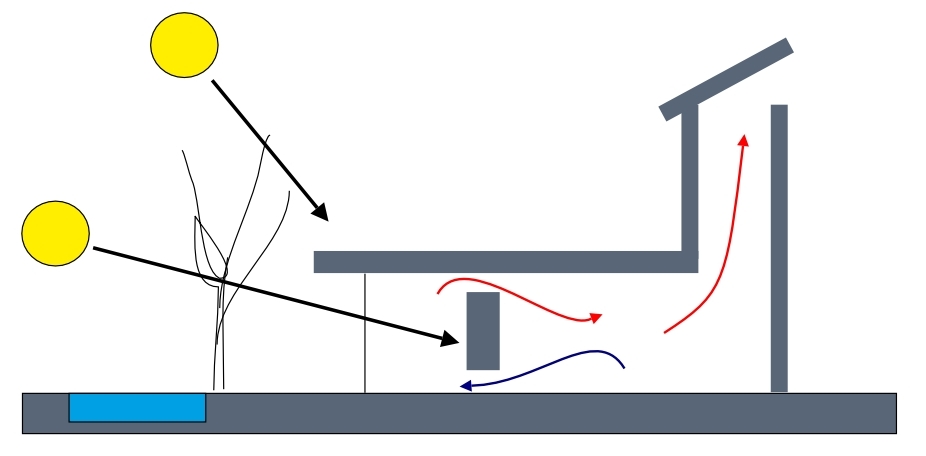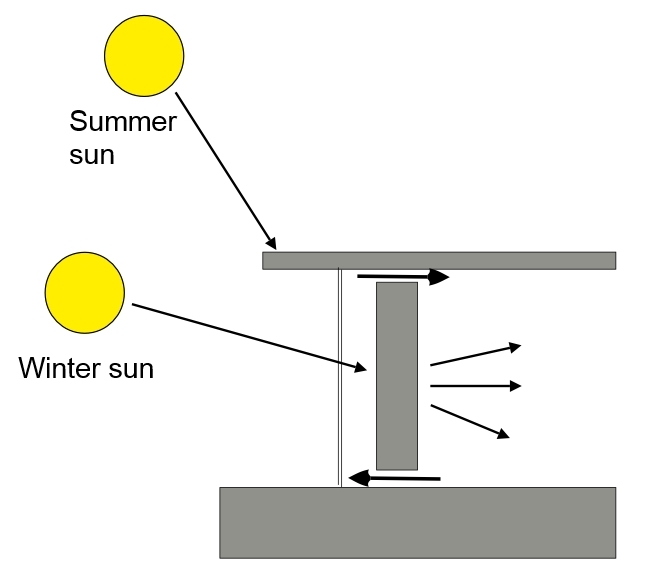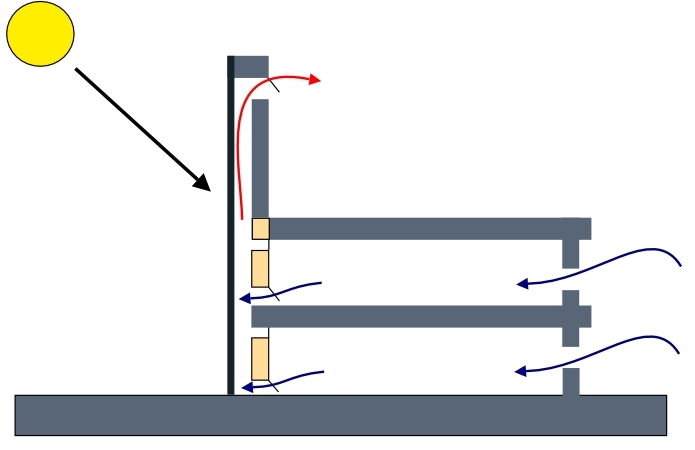Solar gain in buildings
Solar gain is short wave radiation from the sun that heats a building, either directly through an opening such as a window, or indirectly through the fabric of the building. Solar design (or passive solar design) is an aspect of passive building design that focusses on maximising the use of heat energy from solar radiation.
Solar gain is a particularly effective form of passive heating as radiation from the sun is predominately short-wave infrared radiation which is able to pass through glazing and heat the internal fabric of the building. The long-wave infrared radiation that is re-radiated by the heated fabric of the building is not able to pass back out through the glazing. This results in heat accumulating in the interior, sometimes referred to as the 'greenhouse effect'. See Thermal optical properties for more information.
Very broadly, solar gain can be beneficial in cooler climates when it can be used as a passive way of heating buildings. However, too much solar gain can cause overheating and for this reason, Part L of the UK building regulations places restrictions on the amount of glazing that can be used in buildings. Overheating as a result of solar gains can be a particular problem in warmer climates. However, the situation is complicated by the variation in conditions throughout the day and year which can mean that solar gain can be beneficial in the morning and evening, or during the winter, but can be problematic during the middle of the day or in the summer.
Relatively straight-forward design solutions such as brise soleil can be used to allow low-level winter sun to enter a building, but to shade higher, summer sun. Other solutions, such as planting deciduous trees in front of windows can be effective as leaf cover in the summer will shade glazing from solar radiation, whereas in the winter sunlight is able to pass between the bare branches and enter the building.
 [Image: Passive design]
[Image: Passive design]
Thermal mass in the building's interior can be used to even out variations in solar radiation, storing gains accumulated during the middle of the day and releasing them slowly, providing an ongoing heat source during cooler times of the day. An example of the use of thermal mass is a trombe wall, illustrated below.
Low-e coatings on glazing can also increase the retention of solar gains by increasing the proportion of re-radiated long-wave infrared radiation that is reflected back into the interior. This effect can be enhanced at night by the use of curtains or shutters.
Maximising the benefits of solar gains can be complex and requires consideration of a wide range of issues:
- Location.
- Landscape.
- Orientation.
- Massing.
- Shading.
- Thermal mass.
- Insulation.
- Internal layout.
- The positioning of openings.
- The thermal optical properties of openings.
- The thermal properties of the building envelope.
In large or complex buildings, optimising solar gains can be require a great deal of analysis, and may involve the use of techniques such as computational fluid dynamics to model the distribution of heat through the building. Design solutions such as solar chimneys can drive the entire design of the building, its heating strategy and ventilation strategy.
Solar heat gain can be reduced by:
- Horizontal shading.
- Limiting the area of openings.
- Orientating openings away from the sun path.
- Reducing solar transmittance through openings, for example by reflective glazing. This might be used in conjunction with low-e coatings that reduce the long-wave solar radiation transmitted from the outside to the inside.
- Purging heat gains by the introduction of ventilation.
- Insulating the building envelope to prevent the transmission of indirect solar gains.
- Reducing the solar absorptance of the building envelope. The term 'albedo' relates to the total reflectance of a specific system. White coloured surfaces can be effective in minimising heat transfer into buildings.
- Reducing the urban heat island effect.
- Planting to provide shading and to reduce the solar absorption of roofs. See Green roofs for more information.
NB: Solar radiation can also be used to provide heat to buildings through the use of solar thermal panels and solar photovoltaics.
Approved Document O was published on 15 December 2021 as part of the government’s plans to deliver net zero. It covers overheating mitigation requirements for new residential buildings:
- Limiting unwanted solar gains in summer.
- Providing an adequate means to remove heat from the indoor environment.
The aim of requirement is to protect the health and welfare of occupants of the building by reducing the occurrence of high indoor temperatures.
For more information see: Approved Document O.
[edit] Related articles on Designing Buildings
- Albedo.
- Approved Document O.
- Better prediction of overheating in new homes.
- Brise soleil.
- Building fabric.
- Cool roofs.
- Designing daylight solutions for commercial buildings.
- Emissivity.
- EN 17037 Daylight in buildings.
- G-value.
- Large scale solar thermal energy.
- Low-e glass.
- Natural ventilation.
- Part L.
- Passive building design.
- Shading coefficient.
- Solar chimney.
- Solar heat gain coefficient.
- Solar photovoltaics.
- Solar shading.
- Solar thermal panels.
- Thermal comfort.
- Thermal mass
- Thermal optical properties.
- Trombe wall.
- Urban heat island effect.
- Visible light.
Featured articles and news
The UK's Modern Industrial Strategy: A 10 year plan
Previous consultation criticism, current key elements and general support with some persisting reservations.
Building Safety Regulator reforms
New roles, new staff and a new fast track service pave the way for a single construction regulator.
Architectural Technologist CPDs and Communications
CIAT CPD… and how you can do it!
Cooling centres and cool spaces
Managing extreme heat in cities by directing the public to places for heat stress relief and water sources.
Winter gardens: A brief history and warm variations
Extending the season with glass in different forms and terms.
Restoring Great Yarmouth's Winter Gardens
Transforming one of the least sustainable constructions imaginable.
Construction Skills Mission Board launch sector drive
Newly formed government and industry collaboration set strategy for recruiting an additional 100,000 construction workers a year.
New Architects Code comes into effect in September 2025
ARB Architects Code of Conduct and Practice available with ongoing consultation regarding guidance.
Welsh Skills Body (Medr) launches ambitious plan
The new skills body brings together funding and regulation of tertiary education and research for the devolved nation.
Paul Gandy FCIOB announced as next CIOB President
Former Tilbury Douglas CEO takes helm.
UK Infrastructure: A 10 Year Strategy. In brief with reactions
With the National Infrastructure and Service Transformation Authority (NISTA).
Ebenezer Howard: inventor of the garden city. Book review.
The Grenfell Tower fire, eight years on
A time to pause and reflect as Dubai tower block fire reported just before anniversary.
Airtightness Topic Guide BSRIA TG 27/2025
Explaining the basics of airtightness, what it is, why it's important, when it's required and how it's carried out.
Construction contract awards hit lowest point of 2025
Plummeting for second consecutive month, intensifying concerns for housing and infrastructure goals.
Understanding Mental Health in the Built Environment 2025
Examining the state of mental health in construction, shedding light on levels of stress, anxiety and depression.
























